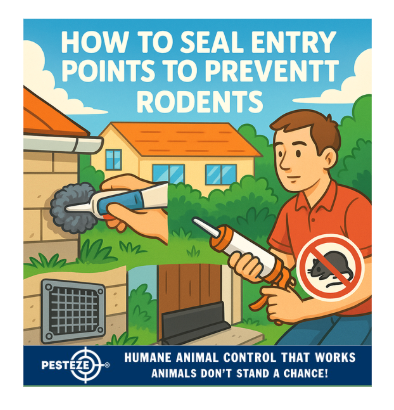HOW TO SEAL ENTRY POINTS TO PREVENT RODENTS

HOW TO SEAL ENTRY POINTS TO PREVENT RODENTS
SUMMARY
This guide shows practical, durable ways to find and seal the small gaps rodents use to enter buildings. It covers inspection steps, recommended materials and techniques, safety checks (so you don't trap animals inside), and maintenance to keep rodents out long-term.
FEATURES
-
Thorough Inspection: Where to look and how to detect entry points.
-
Right Materials: Steel wool, hardware cloth, metal flashing, door sweeps, and foam + caulk usage.
-
Proper Techniques: How to patch, reinforce, and protect vulnerable areas.
-
Safety Checks: Make sure no animals (or young) are trapped before sealing.
-
Seasonal Maintenance: When to re-check and how weather affects seals.
-
Integrated Prevention: Combine sealing with sanitation and habitat reduction for best results
GUIDE DESCRIPTION
Rodents don’t need much space to get inside — mice can squeeze through dime-sized holes and rats through quarter-sized openings — so effective prevention starts with a careful inspection. Walk the exterior and interior perimeter of your building, checking foundations, eaves, vents, utility penetrations, doors, windows, rooflines, and the area where pipes and cables enter. Look for gnaw marks, grease smears, droppings, and scattering of nesting material; these are strong clues to active entry points.
Once you’ve located gaps, choose durable, gnaw-resistant materials. Steel wool (or steel mesh) stuffed into a hole and sealed with exterior caulk is a quick and effective mouse barrier. For larger openings, use 1/4"–1/2" hardware cloth or galvanized welded wire; cut a patch that overlaps the opening by at least 2–3 inches and secure it with screws and washers or masonry anchors. For rooflines and flashing issues, use metal flashing rather than vinyl or wood trim. Door sweeps and threshold seals prevent under-door access; install heavy-duty metal or rubber sweeps on external doors and weatherstripping on gaps around garage doors.
Be cautious with expandable foam: it’s a good filler but alone it’s easily chewed, so use foam as a backing and cover it with metal mesh or hardware cloth. Seal gaps around vents and dryer flues with rodent-proof vent covers; install chimney caps and screen attic and soffit vents with durable mesh. For holes around utility lines, use a combination of metal flashing, foam filler, and a final metal collar so the opening can’t be enlarged.
Before permanently sealing any cavity, always check for animals inside: listen at dawn/dusk for sounds, look for recent droppings, and (if feasible) inspect attics and crawlspaces. If you discover active nests or young, delay sealing and contact wildlife control or animal services for safe removal. Also schedule sealing work during times when young wildlife are independent to avoid orphaning.
Long-term effectiveness depends on maintenance and habitat management. Trim vegetation away from foundations, store firewood off the ground, secure trash, and keep bird feeders away from walls. Inspect seals twice a year and after severe weather. Document all repairs and re-check common weak points such as vents, rooflines, and garage doors.
For large infestations, repeated breaches, or structural challenges, hire a licensed pest-control or building professional experienced with rodent exclusion. Properly done exclusion protects your home, reduces the need for poisons or traps, and is the most humane and permanent strategy for rodent prevention.
- Saneeth Thota


Comments 0